Sometime ago I promised a second instalment from the OSS manual for Allied sympathisers in continental Europe during World War II. For those who have patiently waited, here it is. The manual’s purpose was to show sympathisers how they could obstruct the Nazi war effort by gumming up the works ever so innocently without blatantly risking their lives.
One section was addressed to managers of companies, firms, and organisations from railroads to enamelware factories.
The items read like key performance indicators from McKinsey whose client list has included Enron and Swissair. Remember them?
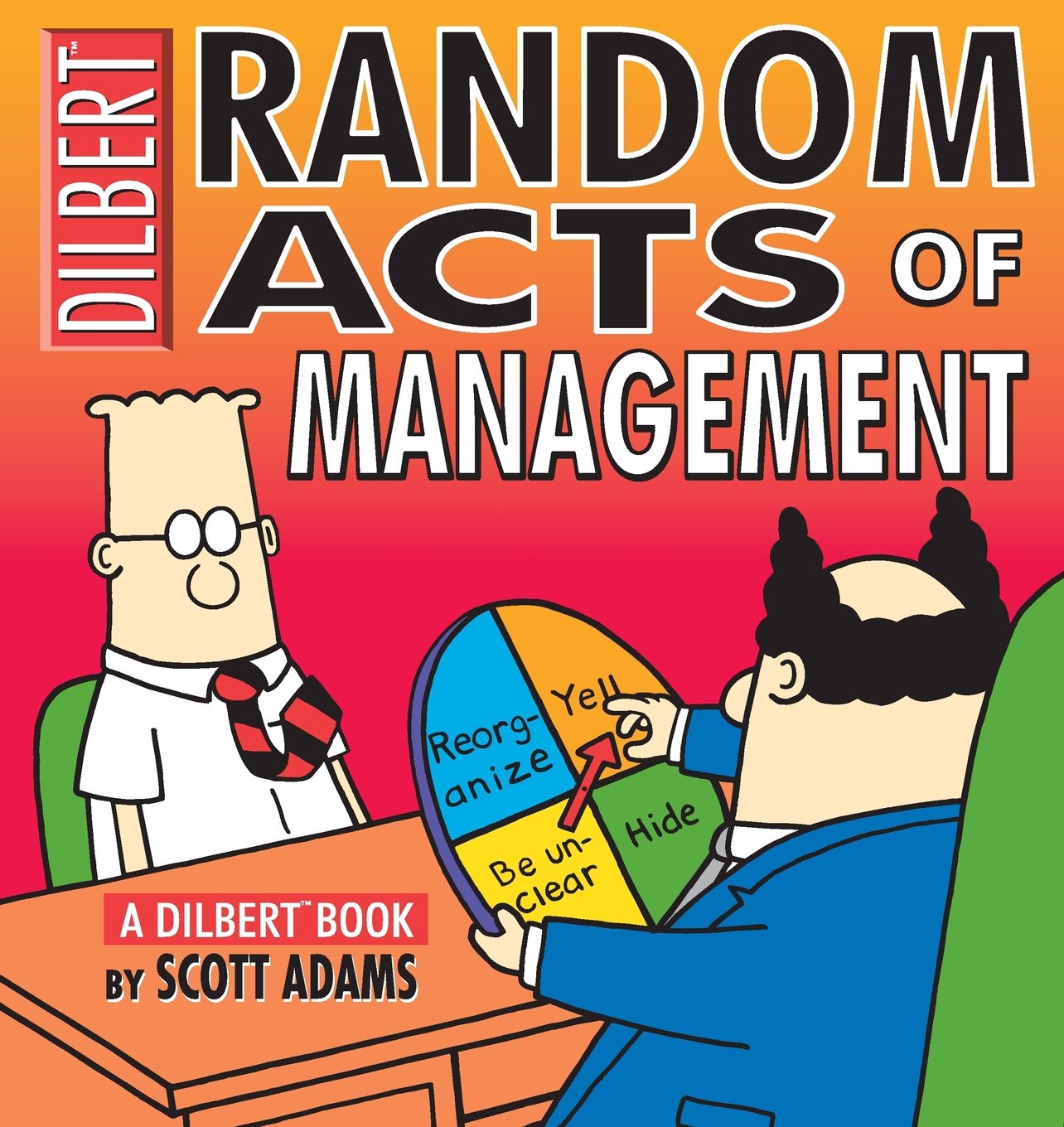
(1) Demand written orders. Meanwhile, time passes and nothing is done.
(2) Misunderstand orders. Ask endless questions about minute details or engage in long correspondence about such orders. Meanwhile, time passes and nothing is done.
(3) Do everything possible to delay completion. Even though part of an order
may be ready, don’t deliver it until it is completely finished. Say that standards have to be maintained. More time passes.
(4) Do not order new raw materials until current stores have been exhausted, so that the slightest delay in filling your order will mean a shutdown. Why? It is inefficient to hold surplus material. Time keeps passing.
(5) Order only high-quality materials which are hard to get. Warn that inferior materials will mean inferior products. There is never enough high-quality material to go around so this order leads to an argument about priorities. These arguments never end. More time passes.
(6) In making work assignments, always assign the unimportant jobs first. See that the important jobs are assigned to inept workers. This is definitely from the McKinsey training course.

(7) Insist on perfect work in relatively unimportant products; send back for revision those products which have the least flaw. Approve other defective parts whose flaws are not going to be detected until use in the hope these products will fail at a crucial moment. Thus one appears fastidious but lets slipshod products through. Another chapter in the training manual, that one.
(8) Make mistakes in routing so that products are sent to the wrong place. A few well chosen typographical errors do the trick. If the reports have not been acknowledged, then one cannot proceed.
(9) When training new workers, assign training to those who have have no experience in the hope that they will give incomplete or misleading instructions. Ah, a favourite of mine. McKinsey all the way. The trainers have never used and never will use the system that they train others to use. A classic.
(10) To lower morale and with it, production, be pleasant to inefficient workers; give them undeserved promotions. Discriminate against efficient workers; complain unjustly about their work. Reward the incompetent and punish the competent. This one has long a key performance indicator for some modern major managers.
(11) Hold meetings when there is more critical work to be done. Do so especially when the pressure is on, declaring that only by discussion can morale be raised.
(12) Multiply paper work in plausible ways. Start duplicate files offsite. Who can object to paperwork? Preparing, sorting, and filing takes time. Assign one of the best workers to this clerical job on the grounds that the paper trail must be perfect.
(13) Multiply the procedures and clearances. See that three people have to approve everything where one would do. Make sure it is always an odd number in the hope that there will be disagreement among them. Invoke our old friend standards again.
(14) Apply all regulations to the last letter. Work to the rule. Was for orders; show no initiative. The more obscure and less relevant the regulation the better. See standards above.
 I never got the pellets.
I never got the pellets.
The OSS was the Office for Strategic Services, the forerunner to the CIA.
Author: Michael W Jackson
‘Pel and the Predators’ (2008) by Mark Hebden
Back in Burgundy with the irascible Evariste Clovis Desirée Pel, Inspector, Police Judiciaire. There are a score of these titles. He is short, with a few of remaining strands of mousy hair stuck to his bald pate, like sparse seaweed on a rock at ebb tide, chronically addicted to smoking two packs of unfiltered Gauloises a day, morbidly afraid of penury, socially inept, near sighted, a hypochondriac, and bad tempered for these and many other reasons. He takes out his bile on criminals who upset the idyll of Burgundy, from which he never willingly departs.

A dead girl who washed up on the distant Breton shore seems to have come from god’s country, Burgundy, and Pel makes routine inquiries that soon prove to be anything but routine. He reluctantly leaves Burgundy to travel to Breton to be briefed. When there, he felt he was standing at the edge of the world. Beyond Breton, beyond France, there is only blackness. His interview with the local detective, Bihan, is priceless. This Bretonnais is an imaginative type who has speculative backstories for everything and this elaboration drives Pel to his cigarettes and beyond. Eventually the point is made.
Back in Burgundy two teenagers exploring each other and a cave find another unidentified body, long buried there, and Pel has to identify it, too. In time these two strands come together, as readers know they must. The two dead women have something in common, though not what one might think. No spoiler.
These titles are police procedurals and there is much plod, and Pel has a team of officers, now enlarged because he has been promoted to Chief Inspector, which elates him, briefly, before he starts thinking about the greater responsibility, and then realises the promotion does not carry a pay raise, then the gloom and doom takes over. Some of the officers are bright, others are hardworking, and a few are lazy and stupid, and Misset is both, but somehow Pel has to work with them all, despite his recurrent urge to hit detective Misset with anything to hand if only to see if he stirs when struck. Pel is sure that Claudie Darel will one day push him out of his job. She is so smart, and knows how to use computers! He has learned to listen to her interpretations of facts.
Pel is some character. Somehow he has entered into a Faustian bargain with Madame Routy as his housekeeper and cook. He does not remember hiring her but there she is and he cannot fire her, since she seems to come with the house. In Burgundy she is the only person who cannot cook. After serving up indigestible stews each night, she plonks on the sofa and watches television at full volume. Ever the worrier, Pel suppose the vibrations from the telly will destroy his house all too soon, leaving him homeless as well as destitute. Meanwhile, he is sure he has some wasting disease.
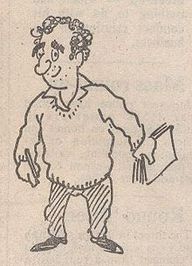 Mark Hebden
Mark Hebden
Into his miserable existence, lightened all too seldom by the chance to bang up a crime, comes the widowed Madame Faivre-Perret, a very successful businesswoman, who seems to have picked him for her next husband, or so Pel fervently hopes when not terrified by the changes marriage would bring to his (dis)ordered existence, and how much it will all cost! Pel is an Olympic worrier. But when he is with her, at lunch, in the cinema, strolling the avenue, he feels ten feet tall and light as air! He even manages not to smoke for periods of ten minutes or more, though she has never said anything, he is sure she disapproves. When he is with her he even smiles! A Pel smile is a rare thing, indeed.
The only other light in his life is the Madame Routy’s nephew, Didier, with whom Pel sneaks out of Madame Routy’s baleful sphere to have snacks at the bistro rather than eat her sludge. How Pel’s shrivelled little black heart sings when Didier, now a teenager, says he wants to be a policeman, and then Pel starts to worry about all the bad things that can and do happen to flics. Can that man worry!
Zachary Karabell, ‘Chester Alan Arthur’ (New York: Henry Holt. 2004)
Chester A. Arthur (1829-1886) was 21st President of the United States (1881-1885).
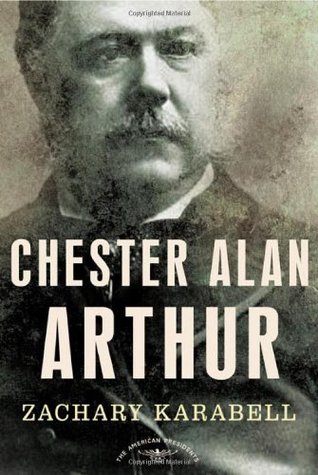
Chet was born in Vermont and went west briefly to make his fortune before settling in New York City. He is often associated with the worst presidents in rankings by historians, along with Warren Harding, Franklin Pierce, Ulysses Grant, Millard Fillmore, and Andrew Johnson. Yet he is the president who signed the Pendleton Act into law, one of the landmarks of 19th Century politics.
His religious father was a devoted abolitionist and Chester, at his urgings, went west to practice law and to keep Kansas a free state. He found the wild west very wild and very far away and stayed only a few weeks before heading back. That was the first, and perhaps the last time, conviction governed his actions.
He made his way in New York by attaching himself as a loyal lieutenant to movers and shakers. He was personally sociable and gregarious, a man who positively enjoyed wiling the night away in men’s clubs where he got to know everyone and offended no one. While he was never anyone’s first choice for anything, no one was ever against him, ergo a reliable second choice at any time.
When the Civil War occurred he duly took to the colours of the New York state militia where he was appointed a quartermaster general by a patron. He secured this plum and cushy appointment, a long way from the cannon’s roar when hapless migrants were conscripted to die in the fields of Virginia, by the grace and favour of one Roscoe Conkling, who at the time and place was a kingmaker.
At the end of his military service, Arthur was a rich man. Our author has it that his law firm made a lot of money. Class, see if this makes sense: As quartermaster general he let contracts worth millions for food, weapons, clothing, boots, animals, fodder, leather goods, and more. Ever heard the word ‘kickback?’ Our author has not. Wikipedia is more suspicious and implies that Arthur used his position as quartermaster general in the most populous state to enrich himself.
He was not especially avaricious about it, but then he was not subtle either. Why bother when it was common practice to do so. Think Tammany Hall, and there is the picture, an alliance of Democrats and Republicans to exploit the government. Has a modern ring to it, doesn’t it?
Moreover this client passed even more ill gotten gains on to his patron, Senator Conkling, who was sometimes referred to as ‘His Lordship.’ Lord Conkling was avaricious and wanted all he could get, in part to bank roll his own plans for the presidency.
Arthur enjoyed luxury in food, furnishing, alcohol, and cigars which he generously shared with cronies in his Fifth Avenue hotel suite, which he kept even after marrying. Indeed the only point of tension with his wife was his persistent networking and socialising at the hotel night after night. She, Nell, died unexpectedly and young and left him a widower who continued the same life.
Conkling had him appointed Collector of the Port of New York by President Rutherford Hayes in a spoils deal. In return for supporting Hayes’s election campaign in New York state, Conkling got to allocate federal government position in the state. It was routine at the time for each new president to dismiss the entire workforce of the federal government and appoint anew those who had supported him, a changeover that might take a year to complete. Call these office seekers. This is the spoils system which had reached its peak by this time.
The Collector of the Port of New York was one of the most important positions in the country. Far more important than most cabinet offices or governor’s chairs. What was collected was tariffs on imports and taxes on exports, and the resulting revenue in New York consisted of more than half of the income of the federal government.
By some quirk of circumstance unknown to our author, Arthur and Conkling became ever richer during his tenure as Collector. Class, figure it out. Whatever, the brandy was French, the cigars were Cuban, the sofas were stuffed, the food was rich, and Chester Arthur moved in the world of J. P. Morgan, Jay Cooke, John Jacob Astor, John Rockefeller, Daniel Drew, Jay Gould, Charles Crocker, Cornelius Vanderbilt, Robert Risk, and other Robber Barons who ran the country while Hayes played at being president. Arthur moved in that world but he was not of it, a hanger on, not a scion.
There is silence about women.
Arthur was much whiskered, carefully coiffured, a dandy with expensive clothes and accoutrements. He liked all of these trappings of wealth, perhaps because they compensated for his lack of good looks, commanding presence, or manly experience in the Civil War or on the frontier. Reading of him I was reminded of a passage from ‘The Great Gatsby.’ Applied to Arthur it would mean he knew himself from the outside in. He wore expensive clothes so that meant he was an important man, and so on.
Arthur was one of the first customers for a new fangled designer who worked with metal and glass, named Charles, Charles Tiffany, who later became famous for his lamps.
After the Civil War the Republican Party, wrapped in Abraham Lincoln’s bloody shirt, was the dominant political force. The Democrats condemned for their association with rebellious southern states dominated a few cities in the north but otherwise were a spent force for decades. In the broad church of the Republican Party there were deep rivalries based on personalities, not ideologies or regions.
The most important one was between the ambitions of Roscoe Conkling and James Blaine of Maine for the presidency. These two were alike in their ideology-free ambition and unalike in every other way. Conkling was a bon vivant, open schemer, sybarite, aggressive, crude, and ill mannered. He fits the 7MATE demographic, a real man’s man.
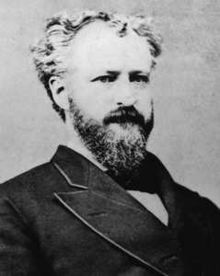 Roscoe Conkling
Roscoe Conkling
Blaine was withdrawn, introspective, perhaps shy, and reflective, more inclined to read Caesar’s ‘Gallic Wars’ than to drink with the boys. More the SBS2 demographic. Their respective factions divided the Republican Party in half.
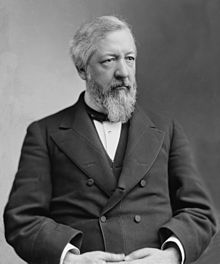 James Blaine
James Blaine
After a succession of Republican presidents, Grant, Hayes, and then Garfield, all Union generals, and the end of the military occupation of the South in the so-called Reconstruction when the seceding states laboured to pay taxes to settle the war debt, the Democrats came back to life. Off and on there was talk of a third term for Grant, which was new to me.
Conkling and Blaine both wanted the Republican presidential nomination in 1880, but more than that, each wanted to be sure the other did not get it. They undercut each other so effectively that James Garfield, who was not a member of either camp got the nomination. To win, he had to make peace with the two godfathers of the party and this he did by promising Blaine the office of Secretary of State and the say in a number of other appointments, which Blaine supposed he could use to plan a later push for the highest office, and by promising Conkling complete sway in New York state. The rivalry had become personal to Conkling and he would not serve in a cabinet that included Blaine he made clear, and New York was good but not enough.
Garfield pondered Conkling’s intransigence and then went directly to Arthur and offered him the Vice Presidential nomination in a move replicated nearly a hundred years later when Jack Kennedy went directly to Lyndon Johnson, no intermediaries, no consultation with trusted advisors. Arthur immediately accepted and shook hands with Garfield.
Conkling was outraged. Which was the greater felony? That Garfield went straight to Arthur without first asking Conkling if he could approach Arthur, or that Arthur accepted without seeking the approval of Conkling. The journalists observing all of this, often in the same room when the deals were done, supposed Arthur would not withstand the inevitable brow-beating from Conkling, and were thus surprised when he later appeared on the podium.
By the way Conkling was nicknamed ‘Lord Conkling’ and he liked that. He liked having graft monies delivered to him while sitting at his desk in the Senate like a lord receiving tribute from vassals
For the first time in his life as an ever loyal second Arthur defied his boss and told him so to his face. Conkling was apoplectic but when he calmed down later, he made the best of if because at least Blaine did not get the nomination and reluctantly allowed his New York state machine to campaign for the Garfield-Arthur ticket.
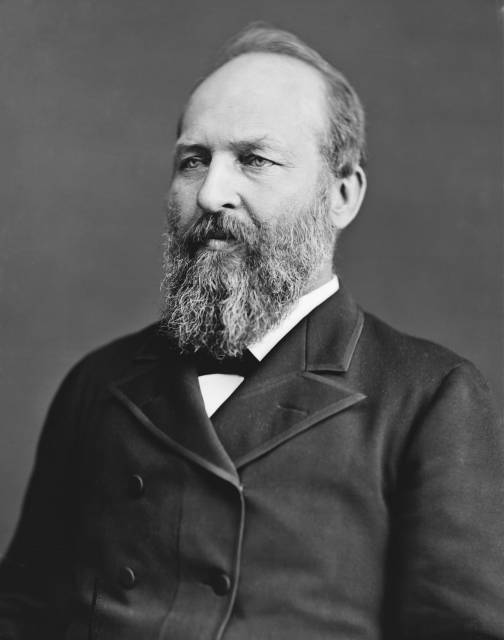 James Garfield
James Garfield
Garfield won and Arthur was installed as Veep, where his major duty, like all before and after him was to preside over the United States Senate’s meetings. This purely nominal duty turned out to be more important than any of the pundits expected for the Senate was evenly divided between Republicans, who had spent a lot of time fighting among themselves, and resurgent Democrats at thirty-seven each. Arthur had the deciding vote and he suddenly became an important person, not just a figure head.
Conkling’s influence nosedived from that day on. In fact, he soon lost his own Senate seat, so gross were his malefactions that even the New York legislators could not overlook them, and he was turfed. now a footnote of history.
Garfield took the oath of office and Blaine became Secretary of State. Three months after that Blaine walked with Garfield to Union Station to take the train to New York City when Charles Guiteau shot Garfield in the back. Two police officer grabbed Guiteau who made no effort to escape. Instead he told the officers that he had shot Garfield so that Arthur could be president, a line he stuck in his subsequent trial. Huh?
Arthur had nothing to do with any of this, that is absolutely sure, but Guiteau said it and more than once. Guiteau was a distant follower of the Blaine camp and he had formed a hatred of Conkling and his influence and he erroneously perceived Garfield to be Conkling’s catspaw. At his trial the defence attorneys argued that Guiteau was insane and that made about as much sense as Guiteau did.
When I learned of Garfield’s murder as a school boy the line was that Guiteau was a disappointed office seeker who took revenge on Garfield for not appointing him to a lucrative federal government office, and this line is still followed in the Wikipedia entry. There is truth in that interpretation because he had written letters asking to be appointed, but it is not what he said.
Arthur was in New York City when the telegram arrived telling him Garfield was wounded. A few minutes later a journalist arrived to tell him what Guiteau had said about him – Arthur. Gulp! ‘What to do?’ he must have thought. He went immediately to Washington to see Garfield, who was comatose and to see Garfield’s wife and family and offer sympathy and aid. He then retuned to New York City and stayed there Incommunicado for the three months that followed while Garfield slowly died.
His reasoning was that he best not appear eager for the office, and indeed, it seems he was not, and so he kept the lowest possible profile.
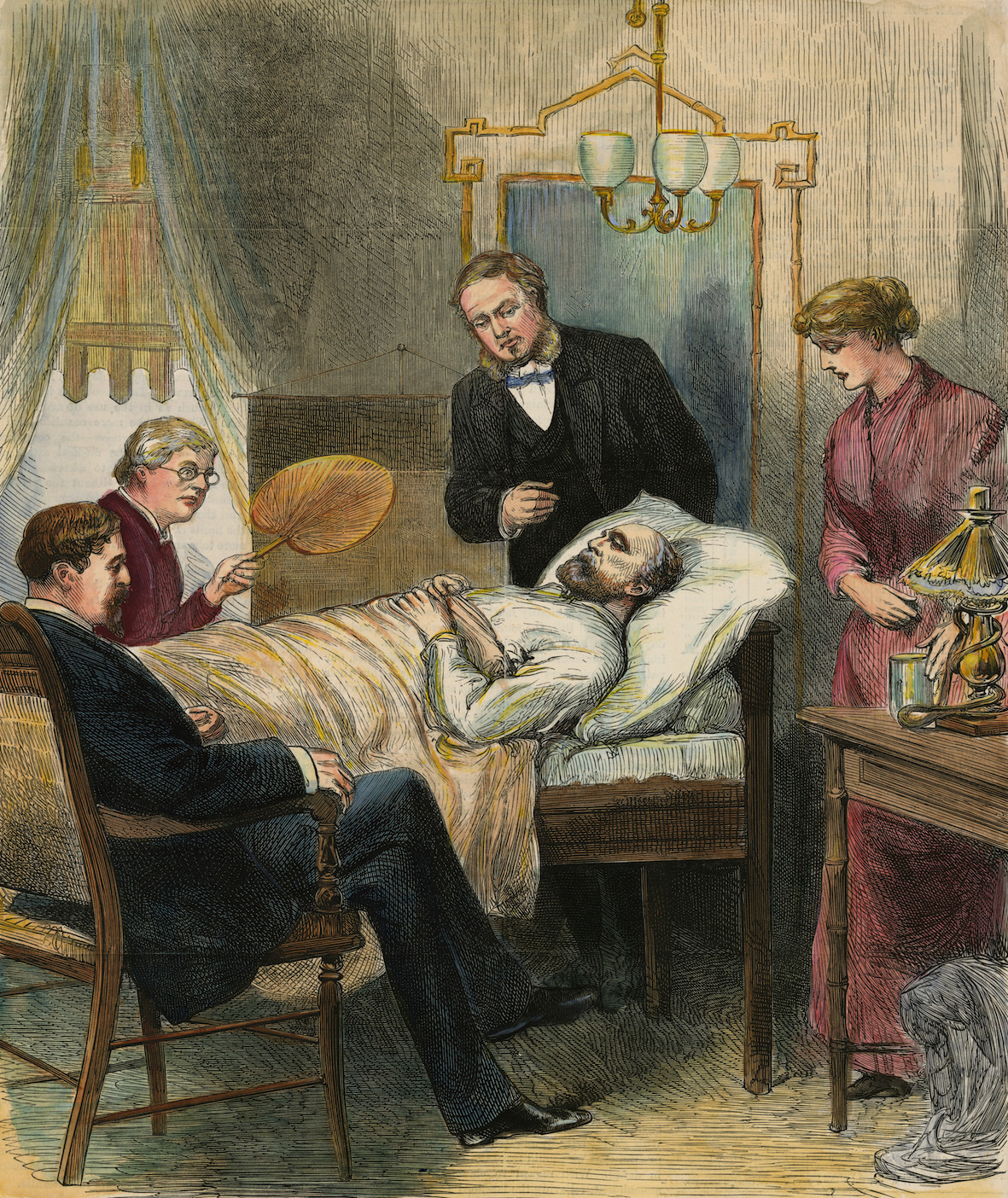 Garfield, wounded.
Garfield, wounded.
Another telegram arrived to announce that Garfield was dead. A local judge administered the oath of office and he was the twenty-first man to be president of the United States on 22 September 1881.
Guiteau argued his own defence, and his blame-shifting reminded me of some people I have worked with. First that Guiteau shot him is Garfield’s fault for walking to the station and so exposing himself to attack, that Garfield died of the wound is the fault of the incompetent doctors who did not save him, and that he died in New Jersey and so a D.C. federal court could not try him. Marvellous, but he was hung.
Arthur returned to Washington and took a hotel suite, leaving the Garfield family in the White House as long as they wanted.
As discrete as he was and considerate of the Garfield family, his incommunicado also meant there was no executive in the government for three months. This is a time when there was constant friction along the vaguely demarcated Canadian border, when European powers flirted with interventions in Mexico and Guatemala while the Indian wars were continuous and anti-immigrant riots were frequent in New York City and San Francisco. Though our author is silent on this I rather think James Blaine may have steadied the ship.
Arthur took the oath of office in Washington and made a short but apt speech some of which is quoted in this book as his ‘inaugural address.’ I balked at that word ‘inaugural’ because succeeding vice-president were not elected to the office of president and so do not give inaugural addresses.
No sooner had Arthur sat down in the big chair than all his drinking buddies, led by Roscoe Conkling, arrived, sat down, and put their feet up his desk, and called him Chet.
This worm turned. Arthur firmly directed them to remove their feet from the president’s desk and henceforth to address him as Mr President. Conkling choked on this rebuke but swallowed it. The others did as they were told. Conkling had expected to secure a cabinet appointment and he also expected to see Blaine dismissed. Neither happened.
At this point Arthur had one outstanding quality. He owned no one anything. No one had expected him ever to be president and so beforehand no one had bothered to extract commitments from him and his incommunicado had prevented later efforts at that. He was his own man. On the other hand, there was nothing he wanted to do, nor was he committed publicly to do anything. He stuck to that with one exception. In all of this there are many parallels with John Tyler who became tenth president.
Installed in the White House Arthur made his sister the hostess, and she set about redecorating the dump, encouraged by Arthur. Louis Tiffany came to the fore and made his reputation there. Virtually nothing had been spent on the White House since it had been rebuilt after the War of 1812. Congress repeatedly refused to fund anything for the president. Before it could be redecorated, much of it had to be rebuilt from the inside out and it was. In the aftermath of Garfield’s death Congress voted this presidential expenditure. The changes wrought as described in these pages sound grand, but all them were ripped out by subsequent occupants to keep up with the fashions of changing times and nothing is left of the Tiffany White House. It all went into the landfill.
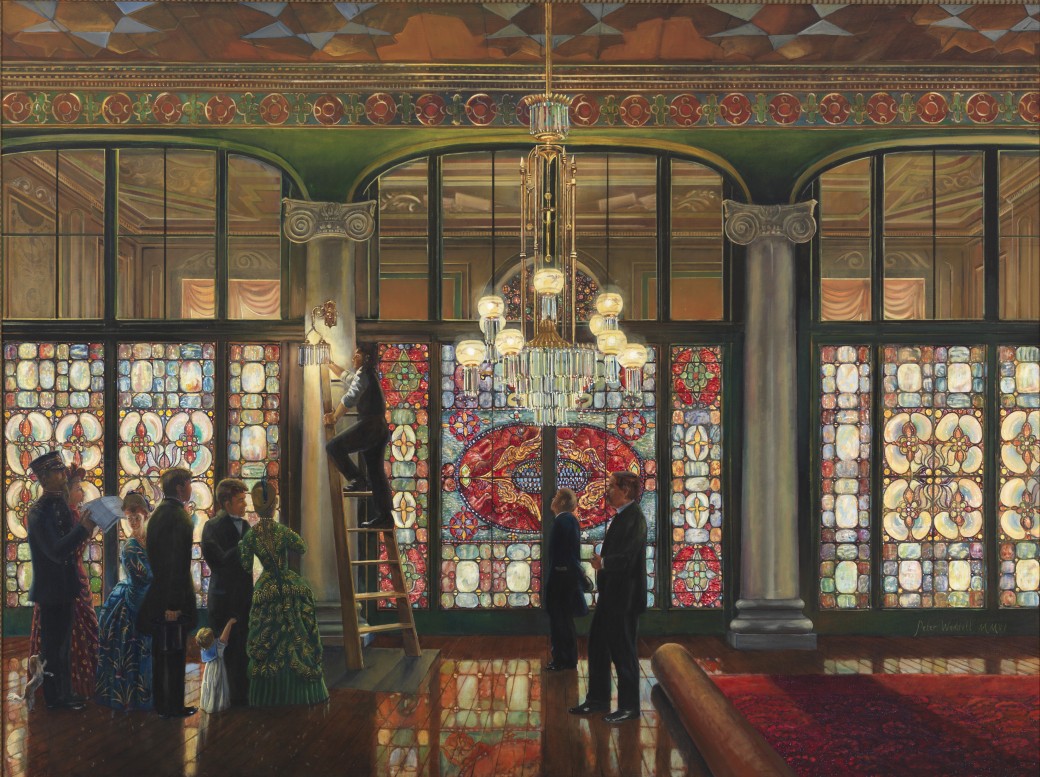 An example of a Tiffany screen like one installed in the White House.
An example of a Tiffany screen like one installed in the White House.
The Robber Barons continued to rob. The army continued to murder Indians. Attacks on Irish immigrants on the East Coast and Chinese on the west were a daily occurrence. British and French interests continued to plot in Central and South America. More than once, shipping on the Great Lakes was interrupted by British patrols.
The federal government had grown during the Civil War and since then business had boomed. The coffers were full and the size of government began to diminish. Arthur ran a surplus and cut excise taxes.
The spoils system, started by Democrat Andrew Jackson, had become a monster that consumed itself in the case of Garfield’s murder for the label disappointed office seeker stuck to Guiteau ever after, and the longstanding minority voices calling for a reform of the civil service were reinvigorated and now heard afresh. The example of the 1854 Northcote–Trevelyan Reforms in Great Britain the generation before was cited and speakers spread the word as did newspapers. The result became the Pendleton Act of 1883 which Arthur, a creature of the spoils system, signed into law, ending the very system that had made him. Ironies of ironies.
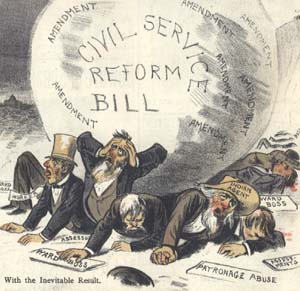
It slowly established civil service examinations for entry, seniority for promotions, ended levies of political contributions from salaries, and myriad of other things. Democrat George Pendleton of Ohio sponsored the legislation in the Senate. When its centenary came in 1983, I was sorry to see it pass pretty much in silence.
The Republicans had long been complacent of their domination of federal politics, but a rude awakening was delivered in the mid-term Congressional elections in November 1882 with Democrats sweeping into majorities in both houses. As a last ditch effort to redeem itself in the eyes of a jaded electorate the old Republicans who still dominated Congress passed the Pendleton Act, which had been languishing in committee for years, to claim the mantle of reform before the new members of Congress were invested in March 1883 and preparations began for the November 1884 presidential election.
One effect of the Pendleton Act was to drive political parties into the arms of business and later trade unions to seek money to campaign the length and breadth of the land. The toxic embrace endures today.
The immediate effect was to undercut Arthur’s support in New York which was entirely based on patronage. The Pendleton Act pleased no one. For the reformers it was not enough and for the spoilsmen is was too much. Thus Arthur alienated his allies and did not win any new friends to replace them. At last Blaine got the nomination for 1884.
Arthur’s high living had also caught up with him in a combination of internal ailments which left him weakened. He died shortly after leaving office at fifty-seven.
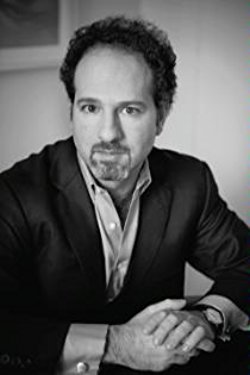 Zachary Karabell
Zachary Karabell
This was an easy book to read and it is sprinkled with insights and some very well turned phrases. It is odd that the author seems deliberately to turn away from the obvious fact that Arthur systematically used public office for his own private enrichment. Yes, others, too, did so but they were not president and he was and they are not the subject of this book and he is. It is also disconcerting to see several references to Thomas Reeves, ‘Gentleman Boss: The Life of Chester A. Arthur’ (New York City: Alfred A. Knopf, 1975) as the authoritative biography. It made me think I should have been reading that. As is the case with books in this series, this one is not based on primary research but rather synthesises existing biographies, and so it remains at a distance from the subject and a reader feels that.
‘Morgue Drawer for Rent’ (2012) by Jutta Profijt
This is the third instalment in this mile-a-minute series that combines science and ectoplasm. Herr Coroner Dr Martin Gänsewein remains saddled with Pascha, late car thief extraordinaire and murder victim. Of all the cadavers in all the pathology labs in all of the world Martin had the bad luck to slice into this one cadaver, complete with a ghost, who can communicate only with him, and who does, often.
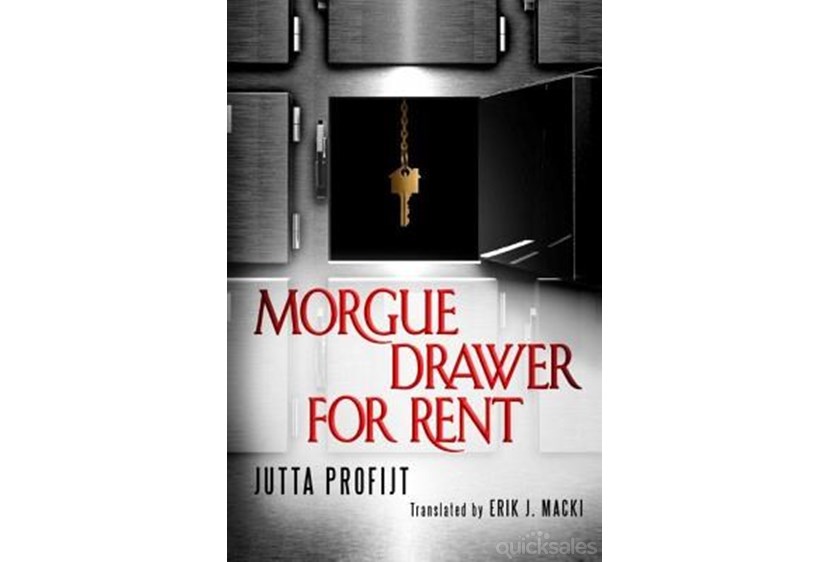
They are the odd couple to end odd couples. Pascha, phantasm though he be, retains his lowlife interests and four-letter word vocabulary, while Martin is a round-shouldered, mumbling, introverted, shy, rumpled, near-sighted, hyper-conscientious scientist who eats lettuce leaves, flosses between his toes, and does not drink alcohol. ‘He calls that life,’ says Pascha with a snort.
In between solving crimes in the first two books, Martin spends much time, effort, and money in the vain attempt to screen out Pascha. Microwave transmissions disrupt Pascha’s atoms, he discovers, but harnessing those at home proves to be challenging and impossible at work. Having a ghost shouting in his mind has disrupted Martin’s slow and uncertain love-life with Birgit, and the fallout has confused his colleagues and friends. At times Martin oscillates between the hysterical and the comatose, caused as we and he know by Pascha’s hectoring.
Pascha can also interact with the voice recognition software of Martin’s computer which he uses to write an account of his adventures that he submits by email to a publisher, without Martin being the wiser. Pascha’s career as a writer is one theme in this romp. He is delighted to be published but angry that the work is called fiction!
Another theme is the new manager of the Forensic Institute of Cologne who is an MBA, charged to increase efficiency and cut costs to the bone. That he knows nothing of the legal environment in which the Institute works, that he cares nothing at all about pathology, that he knows nothing about preserving police evidence, these facts do not cause him to miss a beat. He simply delegates responsibilities to others while undercutting and undermining them. Ah, corporate life! The key performance indicators click over. At least he is no hypocrite, he does not mouth platitudes about the staff, he simply shafts them, belittles them, and shows open contempt for them. A refreshing honesty in that.
All of that is credible and the author must have worked in a large organisation where she observed this kind of McKinsey-speak management.
In no time at all the new boss, whom one of Martin’s colleagues nicknames Piggy Bank, is renting out the morgue’s facilities to funeral directors, who come and go at all hours of the day and night. Soon enough, things go missing, like the body of a murder victim. In the subsequent search for a scapegoat, Piggy Bank’s eyes land on the inoffensive, compliant, and meek Martin. He accepts his fate with resignation, while Pascha is outraged!
Meanwhile, Herr Piggy Bank is completely without scruple or shame. See, I said realistic.
Another of his innovations is to charge the police for consultations with the pathologists. In no time at all Martin has violated Piggy Bank’s many new rules and is dismissed. That frees him to probe more and he does but only because Pascha drives him to it.
Meanwhile, Pascha has stumbled onto the reason for the body snatching, and alerts Martin. It is more complicated than that, of course, because Pascha has fallen in love with Irina, a doctor, and Birgit has laid down the law to Martin about his strange lapses (when Pascha is yelling at him). On top of the that Cologne is hit by a relentless heatwave that makes everyone’s life a misery.
Pascha’s efforts to communicate his feeling to Irina are … extreme. The incorporeal and corporeal just do not mix. As always, his efforts backfire on Martin.
Piggy Bank is a marvellous character, the very model of modern major manager. He is tanned, even in winter we are sure, taut of skin, brisk of manner, clear of eye, devoid of conscience, free of knowledge, completely teflon, seen only when he wants something, totally indifferent to the staff who are only costs, obsequious to his superiors, haughty to underlings, tasseled of shoes, blazer-wearing, and he speaks but key performance indicators, single-mindedly pursuing his own advancement. Sound familiar?
It all comes together, and it all comes out in the wash. The plot is ingenious and kept me guessing until the author produced the rabbit. Then, ‘Voila!’ It all made sense. Several blue herrings added to the misdirection.
 Jutta Profijt
Jutta Profijt
Not all the loose ends were tied. When Martin, on Piggy Bank’s orders, refused to talk to police officer Jenny, she storms off to have it out with Piggy Bank, and….. I don’t know.
The self-deprecating joke the book ends with is delicious. Toilet brush indeed!
‘The Perplexing Theft of the Jewel in the Crown’ (2016) by Vaseem Khan
To coincide with a state visit by Queen Elizabeth II the British Crown jewels go on display in Mumbai. The wing of the museum where this display will sit is specifically built for the purpose to make it thief-proof but attractive for visitors. Any reader can infer the rest.
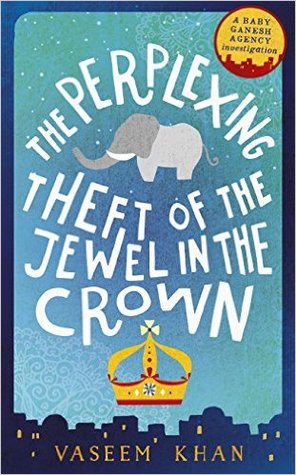
Detective Inspector Chopra, retired, sworn enemy to all crime, is an early visitor with his wife Poppy. But twenty visitors at a time are admitted to the inner sanctum where the crowns, orbs, tiaras, maces, and the Koh-i-Noor diamond are displayed. By the way, ‘Koh-i-Noor’ means ‘mountain of light.’
As Chopra inclines his head to read the card with one display his gaze travels past a face on the other side of the glass case, one that seems familiar, then the lights go out, both in the room and in Chopra’s head, while in the darkened room a gas immobilised everyone even as loud noises faintly registered on those losing consciousness.
Yes, the Koh-i-Noor diamond was taken, and nothing else, in the raid. The back wall of the room blown in (or was it out?) and the unbreakable glass in the case was broken. How could this happen?
When dusted off, Chopra ponders all of this in the back of his restaurant that caters to police officers (who are enemies of crime, and that criterion excludes quite a few) with Ganesha, his pet elephant. Poppy manages the restaurant and she and Chopra have all but adopted the one armed bus boy Irfan, who in turn dotes on Ganesha. Only Chopra’s mother-in-law remains a blue-bottle fly in the ointment, a very conspicuous one since she runs the front of the house at the restaurant, intimating the hardened officers who arrive and infuriating the chef with her interference.
The response to the embarrassing theft of the crown jewel is to slam-up a scapegoat immediately. The key performance indicator is thus satisfied. Who better than the hapless police officer who was responsible for security, an old comrade-in-arms of Chopra who is drawn into the case.
Chopra’s detective agency has prospered for there are many straying husbands to watch and young daughters who may be keeping the wrong company, but while profitable these matters are dead boring, though Ganesha has proven to be an ace at surveillance. He never tires, never blinks, never loses concentration. While Chopra naps in the specially designed baby-elephant transporting van, Ganesha keeps watch and nudges Chopra into consciousness when the target moves. Only in the streets of Mumbai would passers-by not notice an elephant.
To handle the routine cases, Chopra recruits his one-time senior sergeant who has dismissed from the police force by a jealous superior for no reason at all. While the sergeant has no education or training, he knows the streets and people of Mumbai better than anyone else, and his loyalty and dedication are unalloyed. He makes light work of even some tricky cases with Poppy’s help, while Chopra is drawn more deeply into the matter of the crown jewel.
His conversations with the Scots forensic officer that the Brits dispatched post-haste to the scene are amusing examples of culture clash, each lapses in the professional patois and linguistic idioms of their countries to the incomprehension of the other. When the Scot is describing the one-two-three boom of the explosive used, he caps the story with ‘and Bob’s your uncle!’ Chopra’s looks around for Bob. Then he hesitates and says he has no uncle Bob. The Scot thinks this might be a snide remark, but …. We should have heard more from this Scot later in the book but we do not.
Instead we get the red-faced, gigantic, humourless Inspector of Scotland Yard who shadows the investigating Indian officer, whom Chopra knows to be as incompetent as he is corrupt. The Yard Inspector seems to accept that Indian officer’s lead in arresting the security manager, i.e., until circumstances, involving an elephant, throw them together and he tells Chopra that the investigating officer is nutter who ought to be in the slammer himself instead of trying to beat a confession out of a fellow officer. They make an odd couple sort of alliance, pool their evidence and suspicions, and cooperate in an elaborate charade that reveals all. It involves a very large cake, but that is only the beginning. No spoiler.
 Vaseem Khan
Vaseem Khan
The touch is light though some of the material is dark, indeed, and Poppy has her own investigation among the cut-throat world of private high schools. She is ably assisted by the sergeant who has seen through many lies and sees through those told in the hallowed halls of learning.
“The Invisible Gorilla: And Other Ways Our Intuition Deceives Us‘ (2010) by Charles Chabris and Daniel Simons
This book is a popular presentation of some serious studies in the psychology of perception and memory. It shows how counter-intuitive reality can be. It also overstates its case and enforces a technical vocabulary where it adds little or nothing to the general reader, who seems to be the target audience.
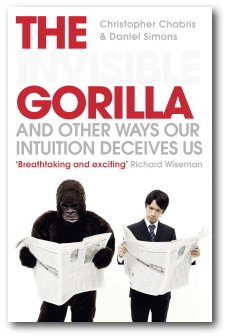
The video that made the authors famous and which explains the title can be found on You Tube. It is a psychology experiment in which observers are instructed to count the number passes a basketball team makes, and while the observers count, a gorilla walks across the court. Well, a student wearing a full-body gorilla suit, since the research grant did not run to capturing and training a complaint gorilla.
Imposible to miss!
Hmm, missed by about 50% of all subjects through repeated iterations and variations.
We can indeed miss things in front of our very eyes, and do so nearly every day. So I say from personal experience. Because we miss them, we suppose they were not there, but they were.
The explanations are many, and in these pages become increasingly, and needlessly, complex, no doubt to justify the grants that produced the fame and book contract(s). My cynicism is showing.
We see most readily what we are looking for. Indeed we often can only see something if we are looking for it, and in concentrating on that, we miss much else. Whoops! But then concentration is supposed to do that, focus.
In parallel we are less likely to see what we are not looking for, and the even less likely to see it, the more out of place it is. This latter is counter-intuitive. But that gorilla is an example. It is completely out of place and, consequently, invisible (to half the watchers). Another player, a coach, a referee, a cheerleader wandering onto the floor might have been spotted more often for the fit the context.
To reiterate. something extremely odd can be the most easily missed. See, counter-intuitive, because one would think the oddest things would stand out, but they do not always do so. Sometimes, yes, but often times no.
Add to this perception blur-memory and the plots thickens. If it is not perceived in the first place but is just a blur, memory cements over it, and it never happened.
The authors demonstrate these failings, which seem very plausible in my own personal experience, with a combination of laboratory experiments and case records of automobile accidents, flight simulator video evidence (nearly enough to put me off flying), conflicting eye witness testimony, and trial records. The range and variety of this empirical evidence is impressive.
One of the governing points is that our contextual expectations shape perception and also memory. We do not expect to see a gorilla while a basketball team practices passes.
There is also cognitive load, which the authors do not give any attention, but they do note that when the task assigned to observers is made more difficult, gorillas sightings decrease. For example, to ask observers to count separately air versus floor passes makes the gorilla all but invisible to everyone. The more complex the assignment, the more concentration it takes, the less attention remains to detect the unexpected.
There is another example of cognitive overload in these pages. Drivers who follow the GPS oral directions despite the obvious mistake it is making. They ignore flashing lights, barriers across the road, and drive off collapsed bridges, over the culverts of incomplete roads, and on to rail way tracks because the computer voice told them to do so. I would like to think I would not do this, but…. I have found GPS directions mistaken when roadworks blocked the recommended routes and had the wit to stop on those occasions. Who knows what the future will bring?
Of course, magicians and other illusionists have long exploited misdirection, distractions, sleights of hand, and lighting to make audiences see what the magician wants its members to see and not what is in fact happening before their very eyes. The authors have not yet referred to this domain in my incomplete progress through this book. Though the illusionists do not publish in ranked journals and apply for National Science Foundation grants, hide behind polysyllabic jargon, nor make mountains out of molehills as scholars must, so they may get short shrift in these pages.
There are many more ingenious experiments to justify research grants. If magicians are neglected so too is the simple fact of concentration. If I am concentrating on counting passes maybe I should not see the gorilla. Perhaps the observers who see the gorilla made mistakes about the pass count. Nothing is said about the accuracy of the observations, but if I were paying pass-counters that is what I would want them to do, count, not notice gorillas. Many of the examples given involve witnesses who are not concentrating. A student passes people on the street, and one says ‘Hello.’ Five minutes later the student cannot describe this person. Well, so what? If that student had been told the description would be on the final exam, it would have been remembered.
Two passengers in a moving car see an assailant pull a bike rider to the ground. Interviewed by police thirty minutes later and they give different description of the assailant. Again, so what? They were not concentrating on the scene. It was a blur.
Of course, the authors’ point, is in part, that such witnesses each individually think they do have an accurate description even when one, if not both, of them must be wrong. It is this confidence that is the underlying problem, and the authors nail that. It is the this also confidence that presents many problems. Agreed, but I am not sure this book has narrowed that down any.
Though in doing so, it seems like overkill. The messages seems to be that no one is ever right in the first place and subsequent memory further erodes. To give up would seem to be the best response to such a hopeless situation.
 I thought of these two when reading about memory in this book.
I thought of these two when reading about memory in this book.
Hmm, well I just watched an American football game and there the players with enormous concentration remembering intricate plays from a manual of fifty or more, in a deafening stadium, driving rain, with hard hitting opponents, carrying injuries, and growing tired toward the end of the season and the end of the game. Memory does work better when one concentrates.
The authors offer some amusing anecdotes to illustrate the fragility of memory but to this reader that is all they are: anecdotes. Men often appropriate each other’s stories as their own in the retelling and when challenged about it, get very defensive. (I have even seen women do this.) What is going on in such cases is not primarily a false memory but a stupid lie followed by a masculine refusal to admit it. No National Science Foundation grant is required to explain this everyday event.
More disturbing are airline pilots in simulators who are so absorbed in reading gauges that they do not notice the tanker-truck on the runway.
A tendency in this book is to name a ….a what? … a syndrome, and then move on to another ingenious experiment. The missed gorilla and the missed tanker truck are treated as instances of the same tendency and yet they differ so much in context and consequence as to be different in kind.
Moreover, to this lay reader (I thought about say layman to see if it would arose a comment about gender but I forgot) that the nominalism is not very informative. By nominalism, I mean naming a pattern of (mis)perception – e.g, inattention to change, and suppose we now understand how it works. We do not; what we have, often in these pages, is a description with a label.
 Charles Chabris
Charles Chabris
 Daniel Simon
Daniel Simon
While I am airing my nits, I find the book replete with name dropping of colleagues and of universities. Perhaps some editor encouraged that to make it more personal and less austere and scientific for a general reader but it makes it read too much like a letter to mom identifying all of the fraternity brothers and sorority sisters. It is all of a piece with the me-ism of the selfie.
Warning! cynicism overload.
Dan Kavanagh, ‘Putting the Boot In’ (1985)
A krimi set in the world of British soccer. Our principal is Duffy, onetime fourth-string goal keeper and retired police officer. His retirement from the force was involuntary. Ahem. This is the second or third title in a long-running series.
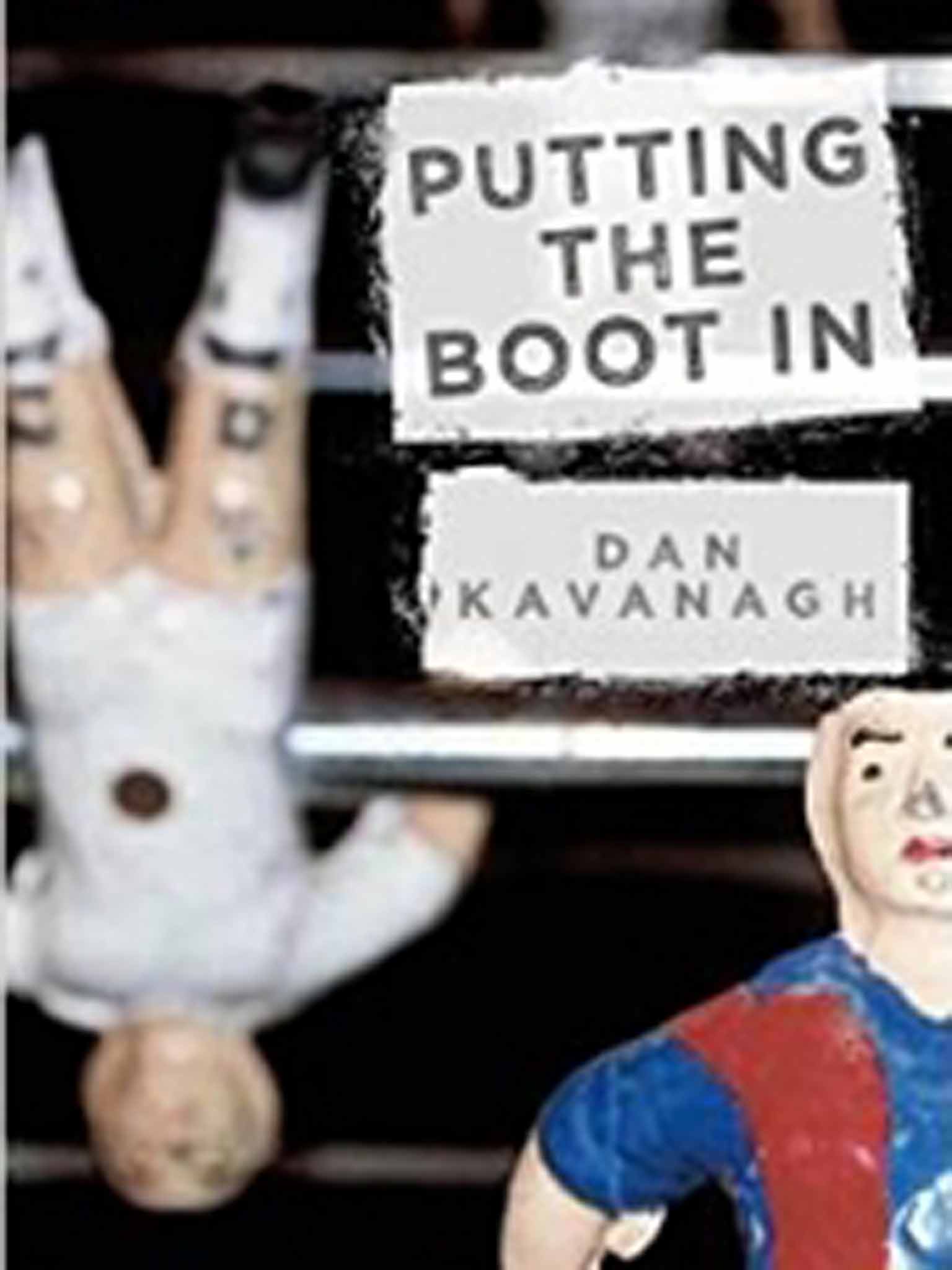
There is quite a bit about the beautiful game, which passed over my head. I liked the ambiguous attitude and behaviour of the owner of the third division team at the centre of the mystery. If the team is relegated, well, he will sell the ground for a commercial development and, perhaps, break up the team. If the team has a few wins and hangs on, well, then he will stick with it long enough to sell it to another punter at a good price. Win-win for him. Not so for the fans whose team may disappear. Not so for the manger who will be blamed for relegation. Not so for most of the players whose fortunes are tied up with this team; there is not a lively market for fourth division players. A few of the better players will get other offers.

Some of the players are involved, along with the desperate coach for whom relegation of this team would be the end of his credibility and career in the Old Dart. He is so desperate he hires Duffy and pays him out of his own salary, which amuses both the owner and Duffy.
Duffy, per the back matter, is AC/Dc on sex. But here his battery is flat.
Someone has been nobbling the players. One has his leg broken in a choreographed mugging, while another is set up on a sexual assault charge. Duffy to the rescue. Well, sorta. In the end the leg will heal and the sex charge lapses when the complainant decamps, perhaps, because of Duffy’s pressure, or perhaps because the punter who paid her in the first place lost interest. Like life, it is unclear.
Duffy lives with Carol but that seems to be all. She has access to some police computers and that comes in handy when he can talk her into using that access for his purposes. Not often that.
Trouble is, I found the characters monotonous. They all blended. It seemed like a very long episode of ‘Minder.’ Neither much plot, tension, nor momentum, but some good one-liners.
 Dan Kavanagh
Dan Kavanagh
I came across this title on the shelf in the Academic Bookstore across from Stockmann’s in Helsinki, and snapped the cover. Later I said hey presto and got it on the Kindle. I had no wish to carry the paperback around.
‘The truth is out there.’
Fox Mulder said that. Such a remark would have earned him a sneer in most universities, especially from philosophers, the more so for those who declaim themselves to be post-modernist.*

For the last two generations scholars and writers have been telling students there are no facts. Marxists denied the law of supply and demand as a fraud. Philosophers emerged from Plato’s cave. blinded by the sun, saw no facts but only heard words and more words. It was all relative. Then the post-modernists came along and bulldozed everything flat with Gallic subtlety. It is all subjective.
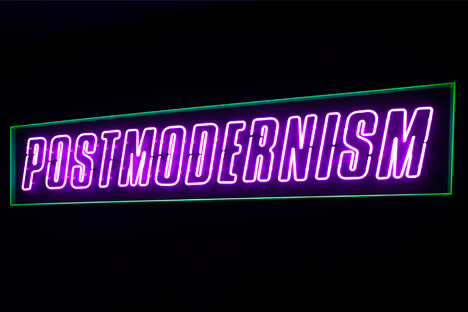
In a curious way even school teaching went along with this rarefied nonsense by increasingly ignoring facts. Students no longer learned facts, like historical eras, conjugations of verbs, the formulae for a solution, or the dates of queens and presidents. If such trivia was needed it could be looked up. This was the line long before Google came along.
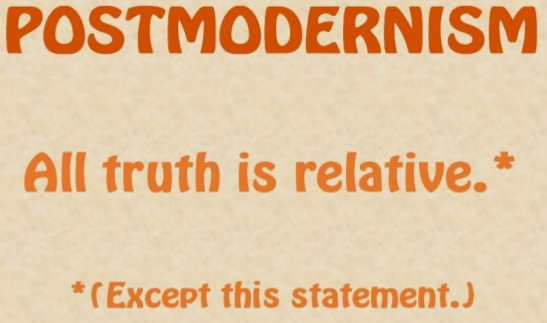
As ever, the nonsense peddled in college and university classrooms seeps out with the graduates and in time it come back to haunt the groves of academe. What started as intellectual pyrotechnics, harmless fun, and oneupmanship, and the path to promotion is not so funny when it mutates and returns to bite. Think Godzilla.

Now politics in the United States, and to some extent in Australia, has practitioners who publicly and explicitly dismiss facts. The lesson has been learned. Climate change may be a fact but that does not privilege it. All is relative, a fraud, or subjective. Hearing a minister of the crown dismiss scientific evidence sounds like a philosophy seminar.

Social workers were bitten by their own arguments years ago when they espoused the conviction that disabled people should not be institutionalised as this further diminished them. In time the political class learned this lesson and closed the institutions to cut budgets, putting the disabled in ‘the care of the community,’ that was the phrase trumpeted by social workers forty years ago. That care is now to be seen in such people sleeping on the sidewalk and living in parks. In addition, the career paths created in larger institutions were closed off to social workers.
*I have always expect the worst when I hear the word ‘post-modernism’ and so far it has never let me down.
I hemmed and hawed about ‘oneupmanship’ but decided to us it since its prime exponents are men.
‘Arrival’ (2016)
We idled away a hot and humid Sunday afternoon at the Newtown Dendy to see ‘Arrival.’
First contact with aliens is a gold standard in science fiction. Many examples are shoot ‘em ups from ‘The War of the Worlds’ to ‘Independence Day’ and their kind. Nothing more will be said about these sort.
Before going to ‘Arrival’ I checked an on-line trailer to see if it met our preliminary standards, little or no CGI and little or no shoot ‘em up. CGI is Computer-Generated Images, which are a fatal virus in most movies these days, an easy substitute for thought. It passed these two tests which rule out most of the dross from the dream factory.

Off we went. What’s to like?
First and foremost its lead and star is a woman, who is neither glamorous nor trying to be a man. Amy Adams plays a skilled linguist named Dr Louise Banks. What she does is listen and think. That is a tough ask for Hollywood: thinking.
The usual currency for thought is the full face close up with wrinkled frontal lobes, but we get little of that here. Instead we get a lot of flashbacks, flash forwards, or flash sideways. I am not sure which, and will return to this point below. Adams does it well, and carries virtually every scene, certainly every scene worth watching.
The movie has pace but it is in no hurry. There is movement but not those crazy camera cuts loved by action directors who have never been in action themselves.
There is an intellectual puzzle — how to communicate with these aliens, who are very alien — placed in a high-pressure context.

We loved all those alien zeros with their minute differences.

They were incomprehensible. That is the mystery. What a relief from the NRA-approved Hollywood films, made by bleeding heart liberals, where all solutions lie in a gunsight. Bam! See any of the recent Star Trek movies. Incomprehensible is better than splat.
In the original ‘The Day the Earth Stood Still’ (1951 [and 2008]) Patricia Neal had to say ‘Gort, Klaatu barada nicto.’ It worked. Whew!
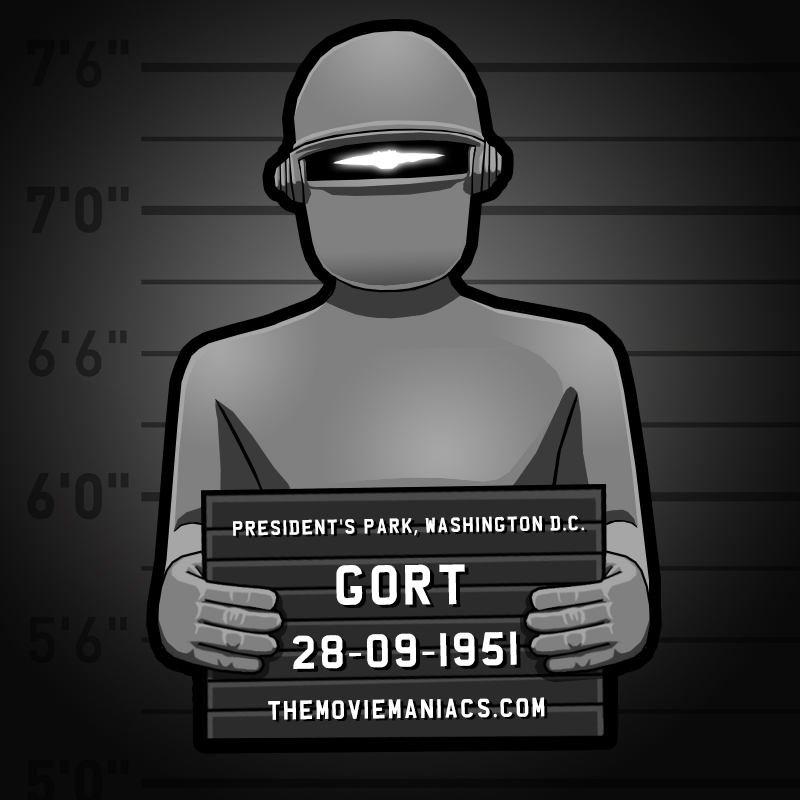 Gort.
Gort.
To do that she had to get to the right place passed the guards, overcome her own fears for herself and her child, and remember the incomprehensible message, and deliver it by rote to the scary robot. That was hard. Especially when his light went on. See above.
Dr Banks’s mission is infinitely harder. With all the same fears that Neal had, she has to figure our first what it means and then how to say it in zeroes. That is some tough exam. It is even more difficult than understanding something said by the Cheeto President-elect.
The biggest theme is time’s arrow which seems to be the governing narrative.
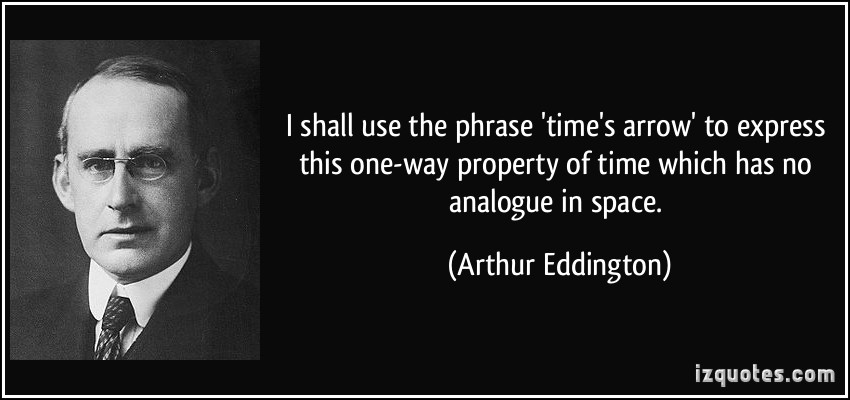
However, neither of the professional reviews I read from the ‘New York Times’ or ‘Sight & Sound’ mention it. All the flashes, back, front, side, seem to be about the simultaneity of time about which we might find out more in a sequel three thousand years later. (To get the point, see the movie.)
I also liked the understated Forest Whitaker for whom dealing with aliens is another day at the office. Indeed, he is almost catatonic. Of course, it is unlikely a mere colonel would have command of such a situation, though most generals would try to avoid the likely career-ending duty. The massive overkill of the U.S. response rings all too true. The motto of the Pentagon seems to be ‘Nuke the jaywalkers!’
Not so likeable were these things.
The dark cinematography defeated some of the exercise. I never did get a good look at Whitaker or anyone else. I expect it will be even more difficult on DVD.
 See what I mean?
See what I mean?
The helicopter landing at the start is gratuitous, distracting, and unbelievable. The helicopter is seldom the fastest way to travel because its airspeed is nothing special, especially when in civilian airspace full of other aircraft. The noise distracts from the dialogue. It is unbelievable that a pilot would land in a wooded residential area at night.
‘They have to see me,’ Dr Banks says ripping off her Hazard Suit (coloured to remind us of ‘Space Odyssey’ I suppose) mask for no discernible reason than that its time to get that Hollywood star our of the glare of the plastic mask.

That the hero is bold where others hesitate is a tired trope trotted out here several times. Cemeteries are full of such bold wanna be heroes who never made it to celluloid fame.
The nicknames ‘Abbot and Costello’ come from nowhere and went right back there. While we silverbacks got it, did anyone else, or have these two execrable comedians been resuscitated? I hope not. Unless it referred to the two Australian politicians Tony and Peter.
The screenplay has its share of clichés. Top choice is the Chinese general who has mastered McKinsey-speak when he says that Dr Banks ‘reached out to him.’ I have heard that too many times from cliché-speakers who did the training course. At least he did not insert a meaningless ‘actually’ in his remark. The scene is good and the point is part of the mystery but all of that is deflated by this McKinseyism. The air went right out.
As expected, there is a hot headed soldier, though here the idiot is a working stiff who acts on his own with a few buddies, where in reality it would be an educated and overpaid general in D.C. who wants to blow something up to get another star. Think Sterling Hayden from’ Dr Strangelove’ (1964) and you have the reality of General Curtis LeMay, a one time vice-presidential contender. The aside with Russ Limbaugh, the most shocking of jocks, was perfect but added nothing here.
If the pointless tracking shots, and empty rooms were cut, we could lose thirty minutes and not notice it. It is too long and indeed the longer it goes, the less the tension. A slow leak is still a leak.
I have to enter a plea for the chain of command. In this movie a Chinese general acts without the authority of the Communist Party. Never. All those purges Mao unleashed were partly aimed at cowing the army and keeping under the thumb of the party where it still is. Nor would the Director of the CIA call the shots as rendered here. There is a president to do that. Gulp.
The director, by the way, is Canadian Denis Villeneuve who has many other credits that I have not seen.
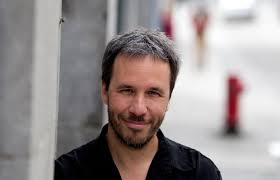 Denis Villeneuve
Denis Villeneuve
Seeing this reminded us of the other First Contact movies. Chief among them is ‘The Day the Earth Stood Still’ as mentioned above in which a passive alien ambassador is murdered by a trigger happy grunt to the cheers of Russ Limbaugh and his kind. Then there was Jodie Foster in ‘Contact (1997).’ A cut above the mill, this one is for its intelligent screen play. In a class by itself is ‘Close Encounters of the Third Kind (1977).’ As is ‘Paul (2011),’ though this not really first contact it is unexpected contact. There are also many instances in the Star Trek canon before the franchise descended into CGI shoot ‘em ups. Some of these are very thoughtful when thinking was still valued out west.
‘Aunty Lee’s Delights’ (2013) by Ovidia Yu
A light weight krimi set in Singapore. ‘Light weight’ is the kind of krimi I like. Not too serious, not too violent, not too graphic, and not too demanding on the little grey cells. I will admit of exceptions like Ross Macdonald and Georges Simenon, but they are few.
This is the first in a series focused on Aunty Lee’s home cooking restaurant in the island city-state of Singapore. Madame Lee is a woman of substance but she loves cooking and running her small restaurant for a crew of regulars since it is far off the beaten tracks in Singapore. She also has a long established and island-wide network of cronies and contacts, some of them from her late husband’s business empire. The final ingredient is her nose for news, i.e., gossip.

The fire is lit when the plastic wrapped dead body of a young woman washes up on one of Sentosa’s beaches. ‘Sentosa’ means peace and tranquility and tidal corpses do not fit the tourist board image. Sentosa also generates enormous income from the twenty million visitors a year who go to this Asian values Disney-like land.
Aunty Lee gets along well with her stepson Mark, who is unable to emulate his father’s business success, but not with his insufferable wife, Selina. She was so insufferable in the early pages I thought, applying years of viewing episodes of ‘Midsomer Murders,’ that she would be the first victim. Alas, no. Though she does largely pass out of the story, or my reflexes have improved and I managed to flip the pages upon which she appeared so quickly I did not notice. I did enjoy a smile when she reappeared toward the end, and the villain slipped her knockout drop so that we readers did have to endure more of her endless verbal and sub-verbal tirades. What’s her problem? She is rich, but not rich enough. And never will be.
Madame Lee’s crime-busting irregulars include Nina, her Filipino maid, and Sergeant Salim, a Malay Muslim, in a city of Chinese Christians and a few others as she pursues the Sentosa murderer. When the victim is identified it is someone she knew. Then there is a second…. Also known to Aunty Lee. This is too much! It’s personal!
I learned quite a bit about the legal status of guest worker maids in Singapore. Sergeant Salim’s outsider status has advantages and disadvantages, as he well knows, and he is learning to capitalise on the former, and gets a few tips from Aunty Lee about managing the latter. That maid, Nina, has her own network to bring to the table.
There is some to’ing and fro’ing in the miasma that is Singapore. A major plot concerns gay couples, and coupling, in Singapore, where it is ILLEGAL! That seemed an odd foundation for the series, though it is well handled, and by the smoke and mirrors of authorship Sergeant Salim is never directly confronted with this crime.
The villain was not hard to spot for us hardened krimi readers but how he came into contact with the two women and dispatched them was neither convincing nor interesting. It also seems to me that early on we had far too much of the egregious Selina for no other purpose than the relief at her subsequent absence. She played no part in the plot. Yes, I now about the false text message but the egregious Selina was not essential to that.
 Ovidia Yu
Ovidia Yu
These quibbles aside, I shall certainly read the second in the series.
In my many business trips to Singapore I never made it to Sentosa. I did walk through the Raffles lobby once and shopped for underwear at the Marks and Spencer, and have since stuck to the M&S house brand via email order. I rode around on the red bus once. Loved the Aladdin’s Cave of the Mustafa Centre, especially before it got all cleaned up. Battle Box in Channing Hill was a grim reminder of the War, as was the replica Changi Chapel. [Moment of silence.]
I had a memorable Thai meal in Singapore in which I made a fool of myself. Long story. Short version: having traveled in Thailand I thought I knew Thai food. Wrong. On all my visits in Thailand the hosts always knew I was coming and all the places I stayed catered, I later realised, for the western palate. The meals in university restaurants and hotels are not the real thing. But place we went in Singapore was! I was hors de combat quick smart.
